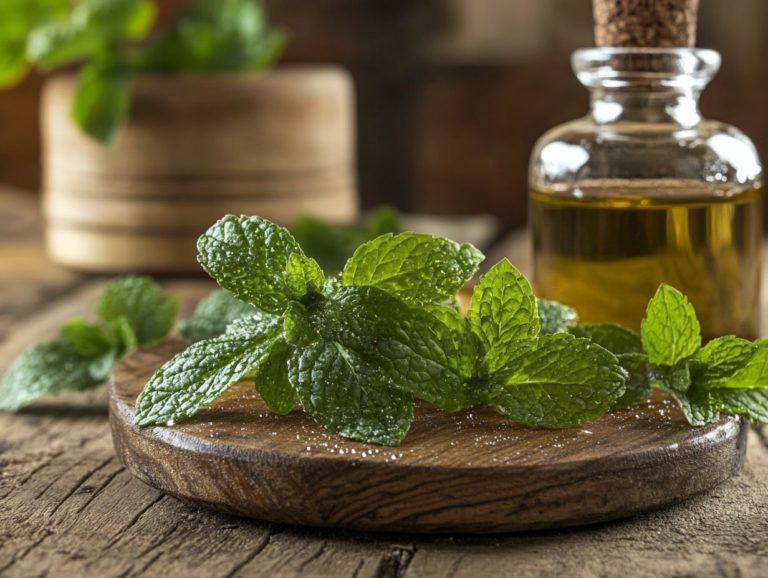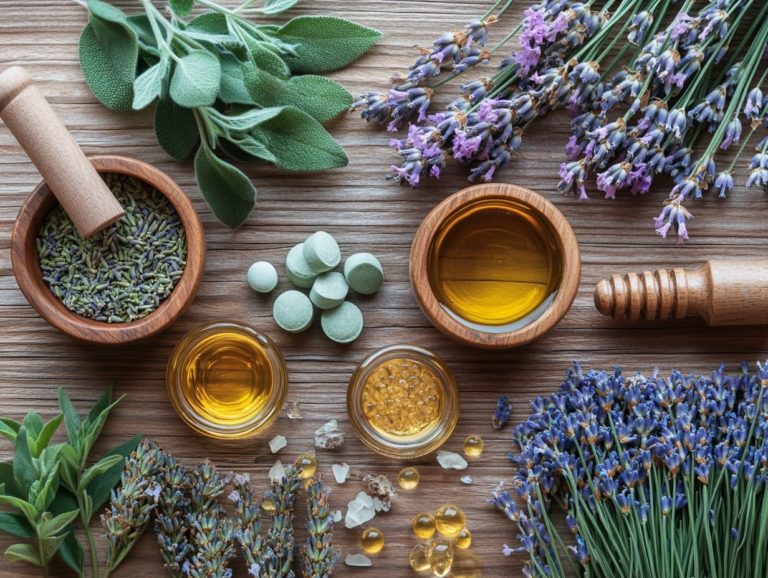Basil: More Than Just a Culinary Herb
Basil is not merely a delightful addition to your favorite dishes; it s a versatile herb teeming with culinary, medicinal, and gardening possibilities.
This article delves into the rich flavor profile of basil, showcasing its common culinary applications while uncovering both its traditional and modern medicinal benefits.
Whether you re eager to cultivate your own herbs or in search of suitable substitutes, you ll find guidance on the various basil varieties along with essential tips for successful growth.
Discover exciting ways basil can transform your kitchen and enhance your well-being!
Contents
Key Takeaways:

- Discover how basil is not just a culinary herb but also a powerful medicinal plant.
- Get tips on growing basil, from choosing the right variety to harvesting and preserving.
- Explore different types of basil and find alternative herbs for your dishes.
Overview of the Herb
Basil, a fragrant herb from the mint family, is a gem celebrated in Mediterranean cuisine for its aromatic leaves and vibrant flavor. This versatile herb boasts a rich history. It originated from ancient lands like Egypt and Greece, and has been cultivated in many forms around the globe.
With numerous varieties, including Thai basil and lemon basil, it plays an essential role in both traditional dishes and modern recipes. Its culinary versatility makes it a staple in many kitchens, enhancing everything from sauces and salads to a delightful array of summer dishes. Basil is often paired with olive oil and garlic to create rich and flavorful sauces.
The significance of basil goes beyond mere flavor; it is a beloved ingredient woven into the fabric of various culinary cultures. In Italian cuisine, for instance, fresh basil serves as the backbone of basil pesto, transforming simple ingredients into a rich sauce that elevates pasta and sandwiches to new heights.
Its presence in Thai salads and curries highlights the herb’s adaptability, adding layers of flavor that invigorate the palate.
Growing basil in your home herb garden not only provides you with a fresh, readily available ingredient but also infuses your outdoor space with a delightful aroma and visual appeal.
Whether you incorporate it into complex recipes or use it as a simple garnish, basil continues to inspire creativity in the culinary world.
The Culinary Uses of Basil
Basil is an essential ingredient that elevates many culinary traditions, especially within Italian cuisine. You ll often find it gracing iconic dishes like pesto, a delightful sauce crafted from fresh basil leaves, garlic, olive oil, and grated Parmesan cheese.
Flavor Profile and Common Dishes
The flavor profile of basil is distinctly aromatic, boasting a sweet and peppery taste that has earned it a cherished place in Italian cuisine.
You ll find it elevating classic dishes like Caprese salad and marinara sauce with its vibrant essence. This unique herb enriches an array of culinary creations, adding both depth and brightness that transforms everything from pizzas to pastas.
Its grassy undertones and subtle hint of anise create a delightful synergy with other ingredients, particularly garlic, which only amplifies its aromatic qualities.
Basil often forms a harmonious trio with parsley and oregano, resulting in flavor profiles that truly shine in dishes such as pesto and bruschetta.
Whether you re sprinkling it fresh atop a steaming bowl of spaghetti or infusing it into sauces, the versatility of basil plays a pivotal role in defining authentic Italian flavors.
Medicinal Properties of Basil

Beyond its delightful culinary charm, basil stands out for its impressive medicinal properties. Often incorporated into traditional herbal remedies, it boasts potential health benefits that include anti-inflammatory and antioxidant effects, thanks to its rich blend of essential oils, which are believed to contribute to its health benefits.
Traditional and Modern Uses
Basil is more than just a culinary herb; it plays a role in various cultural practices. Today, this aromatic green shines as a star ingredient in both savory and sweet dishes.
As a staple in Mediterranean cuisine, basil elevates dishes like Caprese salad and pesto. Its fragrant leaves blend beautifully with ripe tomatoes and creamy cheese.
You might also find basil in unique dishes like basil-infused sorbets or vibrant cocktails. This shows just how adaptable it is!
Many are learning about basil’s potential benefits. It has anti-inflammatory properties and is rich in antioxidants, merging tradition with modern wellness trends.
Growing and Harvesting Basil
Growing basil is rewarding, whether in containers or a garden. Enjoy fresh leaves all summer long to elevate your meals.
Embrace the joy of nurturing basil and indulge in its delightful flavors in your dishes!
Tips for Cultivating Basil
To cultivate basil, choose the right container or garden space. Make sure it gets plenty of sunlight and has ideal soil conditions.
Basil thrives in well-draining soil enriched with organic matter. Aim for a pH level between 6.0 and 7.0, which measures how acidic or basic the soil is. Ensure it gets six to eight hours of sunlight daily.
Be vigilant, as pests like aphids and whiteflies can threaten your healthy plants. Regular monitoring and using natural deterrents, such as insecticidal soap, can help.
When it s time to harvest, remember to pick leaves regularly to encourage bushier growth. Always snip just above a leaf node to promote further branching, ensuring a generous supply of fresh basil throughout the summer.
Basil Varieties and Substitutes

Basil comes in various types, each with unique flavors and aromas. For example, Thai basil offers a delightful licorice-like taste, while lemon basil is celebrated for its bright, citrusy notes.
Both make exceptional substitutes in many culinary applications, elevating your dishes with their unique profiles.
Exploring Different Types of Basil
Exploring different basil types reveals a world of flavors. From sweet Genovese basil to the spicy notes of Thai basil, each offers culinary benefits.
The robust flavor of Italian basil enhances classic pesto and tomato sauces, making them ideal complements to pasta. Conversely, the distinct anise-like taste of Thai basil adds complexity to stir-fries and curries, solidifying its status as a staple in Southeast Asian cuisine.
By understanding these unique varieties, you can effortlessly choose the right basil to enhance your dish, amplifying its overall appeal and flavor profile.
Alternative Herbs with Similar Uses
Several alternative herbs can effortlessly substitute basil in your cooking, each bringing a unique flavor profile that enhances your dishes. Think of options like parsley, thyme, rosemary, and mint exciting choices that can open up new avenues for your culinary adventures.
These herbs contribute their own distinct tastes and elevate the overall flavor experience. For example, parsley adds a fresh, grassy note that beautifully complements sauces and salads. Thyme introduces a subtle earthiness, perfect for roasted vegetables or hearty stews.
Rosemary, with its robust, pine-like aroma, works wonders in marinades. Meanwhile, mint offers a refreshing twist that can brighten salads and desserts.
Combining these herbs with basil creates an exciting blend of flavors. Picture a vibrant pesto that marries basil and parsley or a savory roast that integrates rosemary with basil for an aromatic flourish. Exploring these alternatives can truly transform your familiar recipes into something extraordinary.
Frequently Asked Questions
What is basil? How does it play a role in various cuisines like Italian and Indian cuisine?

Basil is a type of herb known for its unique smell and taste. It has been used in traditional medicine and cooking for centuries, particularly in Italian and Southeast Asian cuisines.
What are the health benefits of basil?
Basil is rich in antioxidants and has anti-inflammatory properties. It is also a good source of vitamins A, K, and C, as well as minerals like magnesium and iron. Some studies have shown that basil may have anti-cancer effects and can help improve cardiovascular health. The genus for basil, called Ocimum, shows its importance in medicine.
Is basil only used in cooking?
No, basil has a wide range of uses beyond cooking. It has been used in traditional medicine for its antibacterial and anti-inflammatory properties. Additionally, it is commonly used in essential oils for aromatherapy and as a natural insect repellent. Many users appreciate the versatility of basil as a seasoning in both food and medicinal applications.
What are the different types of basil?
There are many varieties of basil, including sweet basil, Thai basil, lemon basil, and holy basil. Each type may have a slightly different flavor profile and is used in various cuisines around the world. For example, Thai basil adds a unique flavor to Indian cuisine and dishes from Egypt and Greece.
Can I grow basil at home?
Yes, basil is an easy herb to grow at home. You can plant it in a pot or your garden, as long as it gets plenty of sunlight and water.
Having your own supply of fresh basil helps save money and enhances the flavor of your dishes. It’s a rewarding experience to grow your own seasonal herbs!
What are some creative ways to use basil in cooking?
Basil can be used in more than just pasta and pesto. Try making flavored oils, adding it to salads and sandwiches, or even creating refreshing drinks like basil lemonade and cocktails.
For a delicious twist, pair basil with Parmesan cheese to enhance your Italian dishes. Get creative and see how you can incorporate basil into your favorite recipes!






